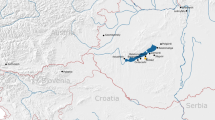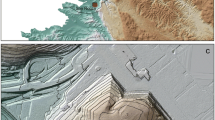Abstract
This study presents preliminary results of petrographic and X-ray fluorescence analyses of cut stone blocks used for urban construction at Teotihuacan, the capital of a regional state in Central Mexico (ca. AD 150–650). Cut stone blocks were concentrated in the civic-ceremonial core of the city and were probably prestigious architectural elements due to their higher costs of procurement and transportation compared to alternative materials (boulders and clay amalgam). This suggests that the organization of stone block procurement and distribution was likely embedded in power relations between commissioners and mining groups. By combining multiple analytical methods that complement one another, this study was able to discriminate local (within 10–15 km radius) from non-local materials. The results suggest that the majority (> 80%) of andesitic cut stone blocks were brought from non-local sources. This paper discusses procurement organization and suggests that most rocks were quarried by specialized groups and brought to the city through a tribute system and/or patron-client relations. This has implications for understanding the nature of the urban-hinterland relationship and expansion of the Teotihuacan state.















Similar content being viewed by others
Notes
Standard reference materials from the following institutions were used to calibrate the ElvaX spectrometer: National Institute for Standards and Technology (NIST): SRM278 (obsidian rock), 688 (basalt rock), and 1633b (coal fly ash); United States Geological Survey (USGS): AGV-1 (andesite), BCR-1 (basalt), BHVO-1 (Hawaiian basalt), BIR-1 (Icelandic basalt), G-2 (granite), GSP-1 (granodiorite), RGM-1 (rhyolite), SDC-1 (mica schist), STM-1 (nepheline syenite), and W-2 (diabase); and Geological Survey of Japan (GSJ): JA-1 (andesite), JB-2 (basalt), JG-2 (granite), JGB-2 (gabbro), JR-1 (rhyolite), and JSy-1 (nepheline syenite). Reference values for NIST and USGS standards are given in the sixth edition of Tables for Neutron Activation Analysis (Glascock 2006). Reference values for GSJ standards are from unpublished neutron activation data produced at MURR and are available upon request.
References
Abrams EM (1994) How the Maya built their world: energetics and ancient architecture. University of Texas Press, Austin
Barba Pingarrón LA (2005) Materiales, técnicas y energía en la construcción de Teotihuacan. In: Gallut MER, Peralta JT (eds) Arquitectura y urbanismo: pasado y presente de los espacios en Teotihuacan. Memoria de la Tercera Mesa Redonda de Teotihuacan. Instituto Nacional de Antropología e Historia, Mexico City, pp 211–229
Barba Pingarrón LA, Córdova Frunz JL (2010) Materiales y energía en la arquitectura de Teotihuacan. Instituto de Investigaciones Antropológicas, Universidad Nacional Autónoma de México, Mexico City
Barba Pingarrón LA, Blancas J, Manzanilla LR, Ortiz A, Barca D, Crisci GM, Miriello D, Pecci A (2009) Provenance of the limestone used in Teotihuacan (Mexico): a methodological approach. Archaeometry 51:525–545
Baxter MJ (1992) Archaeological uses of the biplot—a neglected technique? In: Lock G, Moffett J (eds) Computer applications and quantitative methods in archaeology, 1991, vol BAR International Series. Tempvs Reparatvm, Oxford, pp 141–148
Baxter MJ, Buck CE (2000) Data handling and statistical analysis. In: Ciliberto E, Spoto G (eds) Modern analytical methods in art and archaeology. John Wiley and Sons, New York, pp 681–746
Bieber AMJ, Brooks DW, Harbottle G, Sayre EV (1976) Application of multivariate techniques to analytical data on Aegean ceramics. Archaeometry 18:59–74
Bishop RL, Neff H (1989) Compositional data analysis in archaeology. In: Allen RO (ed) Archaeological chemistry IV, vol 220. Advances in chemistry. American Chemical Society, Washington, D.C., pp 576–586
Biskowski MF (1997) The adaptive origins of Prehispanic markets in central mexico: the role of maize-grinding tools and related staple products in early state economies. Ph.D. diss. University of California, Los Angeles
Carballo DM (2013) Labor collectives and group cooperation in Pre-Hispanic Central Mexico. In: Carballo DM (ed) Cooperation and collective action: archaeological perspectives. University Press of Colorado, Boulder, pp 243–274
Carballo DM, Carballo J, Neff H (2007) Formative and Classic period obsidian procurement in Central Mexico: a compositional study using laser ablation-inductively coupled plasma-mass spectrometry. Lat Am Antiq 18:27–43. https://doi.org/10.2307/25063084
Clayton SC (2013) Measuring the long arm of the state: Teotihuacan's relations in the basin of Mexico. Anc Mesoam 24:87–105
Cowgill GL (2000) The central Mexican highlands from the rise of Teotihuacan to the decline of Tula. In: Adams REW, MacLeod MJ (eds) The Cambridge history of the native peoples of the Americas. Volume II: Mesoamerica, Part 1. Cambridge University Press, Cambridge, pp 250–317
Díaz Lozano E (1979) Rocas y minerales del valle. In: Gamio M (ed) La población del Valle de Teotihuacan, Tomo II. Instituto Nacional Indigenista, Mexico City, pp 27–66
Garraty CP (2013) Market development and pottery exchange under Aztec and Spanish rule in Cerro Portezuelo. Anc Mesoam 24:151–176
Gillespie SD (1994) Llano de Jícaro: an Olmec monument workshop. Anc Mesoam 5:231–242
Glascock MD (1992) Characterization of archaeological ceramics at MURR by neutron activation analysis and multivariate statistics. In: Neff H (ed) Chemical characterization of ceramic pastes in archaeology. Prehistory Press, Madison, pp 11–26
Glascock MD (2006) Tables for neutron activation analysis. The University of Missouri Research Reactor Center, Columbia
Greenough JD, Gorton MP, Mallory-Greenough LM (2001) The major- and trace-element whole rock fingerprints of Egyptian basalts and the provenance of Egyptian artifacts. Geoarchaeology 16:763–784
Harbottle G (1976) Activation analysis in archaeology. Radiochemistry 3:33–72
Heizer RF, Williams H (1963) Geologic notes on the Idolo de Coatlichán. Am Antiq 29:95–98
Hernández Javier I (2007) Geología y geomorfología volcánica de la región de los yacimientos de obsidiana de Otumba en el sector norte de la Sierra Nevada de México. Tesis de licenciatura, Universidad Nacional Autónoma de México
INEGI (1979) Carta geológica: Texcoco E14B21, Mexico y Tlaxcala, Escala 1:50,000. Instituto Nacional de Estadística, Geografía e Informática, Mexico City
Jones GT, Bailey DG, Beck C (1997) Source provenance of andesite artifacts using non-destructive analysis. J Archaeol Sci 24:929–943
Latham T, Sutton PA, Verosub KL (1992) Non-destructive XRF characterization of basaltic artifacts from Truckee, California. Geoarchaeology 7:81–101
López Luján L, Torres J, Montúfar A (2003) Los materiales constructivos del Templo Mayor de Tenochtitlan. Estudios de Cultura Náhuatl 34:137–166
Margáin CR (1967) Sobre sistemas y materiales de construcción en Teotihuacan. In: XI Mesa Redonda. Sociedad Mexicana de Antropología, Mexico City, pp 157–211
Millon R (1973) The Teotihuacan map. Part 1: text. Urbanization at Teotihuacan, Mexico, vol 1. University of Texas Press, Austin
Millon R (1981) Teotihuacan: city, state, and civilization. In: Bricker V, Sabloff JA (eds) Supplement to the handbook of middle American Indians, vol.1: Archaeology. University of Texas Press, Austin, pp 198–243
Minc LD (2009) Style and substance: evidence for regionalism within the Aztec market system. Lat Am Antiq 20:343–374
Mooser F (1968) Geología, naturaleza y desarrollo del Valle de Teotihuacan. In: Lorenzo JL (ed) Materiales para la arqueología de Teotihuacan, Serie Investigaciones XVII. Instituto Nacional de Antropología e Historia, Mexico City, pp 29–37
Murakami T (2010) Power relations and urban landscape formation: a study of construction labor and resources at Teotihuacan. Ph.D. diss. Arizona State University
Murakami T (2015) Replicative construction experiments at Teotihuacan, Mexico: assessing the duration and timing of monumental construction. J Field Archaeol 40:263–282
Murakami T (2016) Materiality, regimes of value, and the politics of craft production, exchange, and consumption: a case of lime plaster at Teotihuacan. J Anthropol Archaeol 42:56–78
Neff H (1994) RQ-mode principal component analysis of ceramic compositional data. Archaeometry 36:115–130
Neff H (2000) Neutron activation analysis for provenance determination in archaeology. In: Ciliberto E, Spoto G (eds) Modern analytical methods in art and archaeology. John Wiley and Sons, New York, pp 81–134
Neff H (2002) Quantitative techniques for analyzing ceramic compositional data. In: Glowacki DM, Neff H (eds) Ceramic source determination in the greater Southwest. Monograph 44. Cotsen Institute of Archaeology, Los Angeles, pp 15–36
Neff H, Glascock MD, Charlton TH, Charlton CO, Nichols DL (2000) Provenience investigation of ceramics and obsidian from Otumba. Anc Mesoam 11:307–321
Ogburn DE (2004) Evidence for long-distance transportation of building stones in the Inka empire, from Cuzco, Peru to Saraguro. Ecuador Lat Am Antiq 15:419–439
Pastrana A, Domínguez S (2009) Cambios en la estrategia de la explotación de la obsidiana de Pachuca: Teotihuacan, Tula y la Triple Alianza. Anc Mesoam 20:129–148. https://doi.org/10.1017/S0956536109000133
Quezada Ramírez ON (2016) El Templo Mayor de Tenochtitlan: sistemas, materiales y técnicas constructivas. Tesis de licenciatura. Escuela Nacional de Antropología e Historia, Mexico City
Quezada Ramírez O, Pascal C, López AG (2018) De la cantera a Tenochtitlan: Presencia de rocas de origen volcánico en la construcción y la escultura del Templo Mayor. La explotación de andesita en la cantera de San Bartola Tenayuca, una aproximación etnoarqueológica. Mexico City
Robles García NM (1992) La extracción y talla de cantera en Mitla, Oaxaca. Tecnología para la arquitectura monumental. Arqueología 2(7):85–112
Sarro PJ (1991) The role of architectural sculpture in ritual space at Teotihuacan, Mexico. Anc Mesoam 2:249–262
Schaaf P, Stimac J, Siebe C, Macías JL (2005) Geochemical evidence for mantle origin and crustal processes in volcanic rocks from Popocatepetl and surrounding monogenetic volcanoes, Central Mexico. J Petrol 46:1243–1282
Sotomayor Castañeda A (1968) Estudio petrográfico del area de San Juan Teotihuacan, Edo. de México. In: Lorenzo JL (ed) Materiales Para la Arqueología de Teotihuacan, Serie Investigaciones XVII. Instituto Nacional de Antropología e Historia, Mexico City, pp 39–49
Sugiyama S (2005) Human sacrifice, militarism, and rulership: materialization of state ideology at the feathered serpent pyramid, Teotihuacan. Cambridge University Press, Cambridge
Vázquez-Sánchez E, Jaimes-Palomera R (1989) Geología de la Cuenca de México. Geofis Int 28:133–190
Williams-Thorpe O, Thorpe RS (1993) Geochemistry and trade of eastern Mediterranean millstones from the Neolithic to Roman periods. J Archaeol Sci 20:263–320
Winchester JA, Floyd PA (1977) Geochemical discrimination of different magma series and their differentiation products using immobile elements. Chem Geol 20:235–343
Acknowledgements
The lead author (Murakami) would like to thank the Consejo de Arqueologia for their permission to conduct research, as well as Alejandro Sarabia, the director of the Zona Arqueológica de Teotihuacan, for providing logistical support for archaeological sampling at Teotihuacan. The study presented in this paper was made possible by financial support from the National Science Foundation Dissertation Improvement Grant (BCS-0836716) awarded to Murakami and a National Science Foundation grant (0504015) awarded to MURR. Finally, we thank Chris Oswald for his assistance in the analysis of the samples by XRF and Alex Jurado for editing help for an earlier draft of this paper. Comments and suggestions by two anonymous reviewers greatly helped clarifying our argument and the scope of the paper.
Author information
Authors and Affiliations
Corresponding author
Electronic supplementary material
ESM 1
(XLSX 47 kb)
Rights and permissions
About this article
Cite this article
Murakami, T., Boulanger, M.T. & Glascock, M.D. Petrographic and XRF analyses of andesitic cut stone blocks at Teotihuacan, Mexico: implications for the organization of urban construction. Archaeol Anthropol Sci 11, 1491–1518 (2019). https://doi.org/10.1007/s12520-018-0619-5
Received:
Accepted:
Published:
Issue Date:
DOI: https://doi.org/10.1007/s12520-018-0619-5




